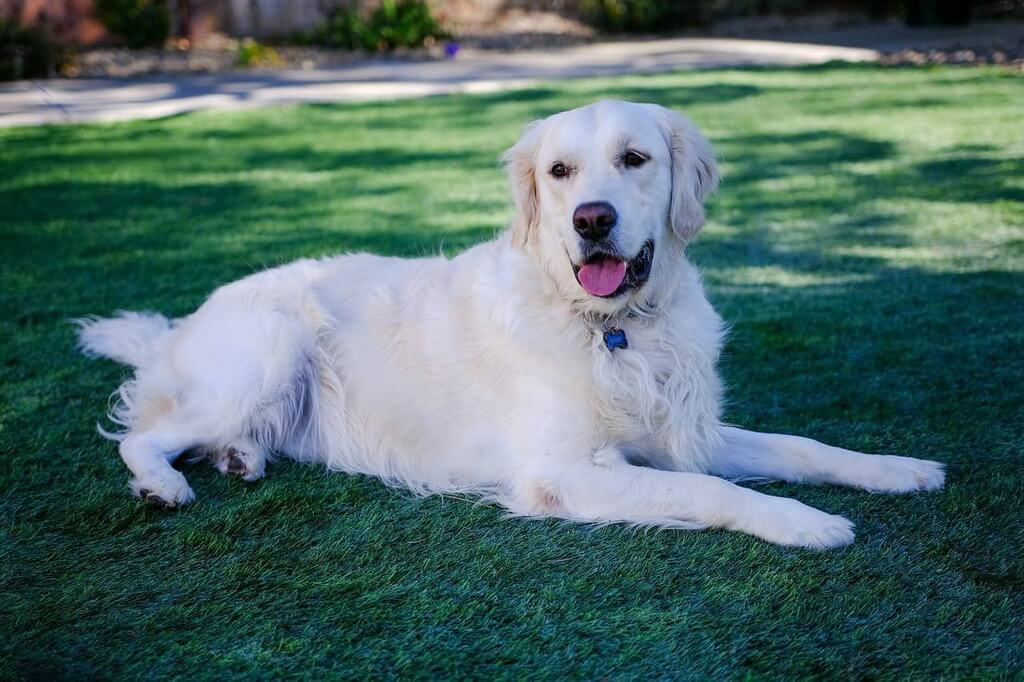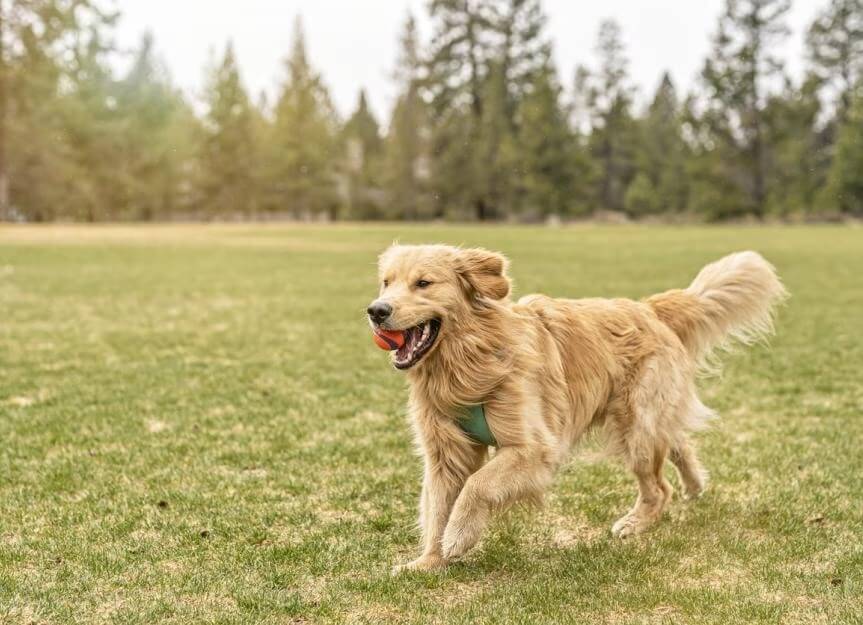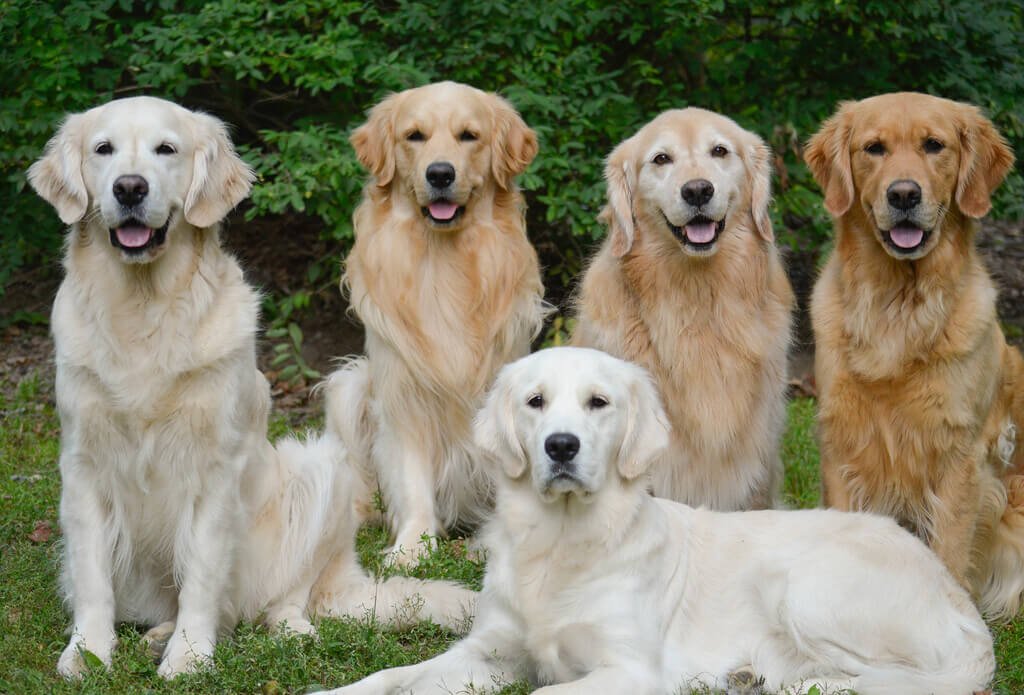
Golden Retrievers rank number three in terms of popularity, according to the American Kennel Club.
Their cute face, along with their loving personality, is the reason why most people prefer to buy or adopt them.
However, there has been a controversy about a new type of Golden Retriever in the market.
If you are reading this article, you may have come across the term – English Cream Golden Retriever.
Today, we are going to clear all your doubts and answer all the questions you may have about this dog breed.
So, sit back and relax while we discuss the English Cream Golden Retriever in detail.
English Cream Golden Retriever Breed Overview
Breed Group: Sporting
Height: Male: 22 to 24 inches at the shoulder, Female: 20 to 22 inches at the shoulder
Weight: Male: 65 to 75 pounds, Female: 55 to 65 pounds
Lifespan: 10 to 12 years
Coat: Long, dense, water-repellent double coat
Color: Cream to light golden
Temperament: Friendly, intelligent, gentle, and eager to please
Needs for Grooming: Regular brushing and occasional baths
Hypoallergenic: No
Origin: Scotland
The Truth about English Cream Golden Retriever

There has been a buzz around the internet about a new and rare type of Golden Retriever with better health and temperament. The breeders are labeling lighter color Golden Retrievers with different names, such as,
- English Cream Golden Retrievers
- Rare White European Golden Retrievers
- Exquisite Platinum Imported Golden Retrievers
However, English Cream Golden Retrievers are not a different breed. They are simply Golden Retrievers with a lighter color coat.
The cream color is simply one variation among the colors found in this breed. The term golden doesn’t really mean that the dog should have a pure gold color coat. These dogs can have different shades of gold.
Despite their name, these dogs aren’t from England.
History
The English Cream Golden Retriever originated from Scotland and dates back to the 1800s. A British aristocrat named Lord Tweedmouth desired to create a dog suitable for both water and land with great hunting skills.
To achieve this, he crossed a Tweed Water Spaniel called Belle with a wavy-coated Retriever named Nous. The resulting puppies, born in different tints of gold, became the first Golden Retrievers. Lord Tweedmouth gifted these dogs to friends.
One of these puppies likely went to Lord Tweedmouth’s son, who owned a red Irish Setter. It’s assumed that breeding the red Setter with the Golden puppy led to the creation of deep red Golden Retrievers. The English cream color emerged from breeding the light-colored Golden Retrievers.
As the Golden Retrievers gained popularity, they started traveling worldwide. Through transatlantic breeding, after years of regional breeding, distinct subtypes of Golden Retrievers emerged. Even though there’s only one breed of Golden Retriever, three main variations became known as Canadian, American, and English varieties.
The Kennel Club initially acknowledged the breed as Golden Retriever in 1911. By 1920, it became officially known as Retriever-Golden. The Canadian Kennel Club recognized the breed in 1925. The American counterparts at AKC also approved it in 1932 and decided to name their golden retrievers.
Appearance

The English Cream breed has the same size and weight as the American counterparts. However, there are some differences between the two types of dogs. The English Cream Golden Retrievers are a bit more robust compared to their American ones.
| Characteristic | Male | Female |
|---|---|---|
| Height | 22 to 24 inches | 20 to 22 inches |
| Weight | 65 to 75 pounds | 55 to 65 pounds |
When it comes to appearance, English Creams have slightly bigger heads and stronger necks. They also have broader muzzles, resulting in a more powerful jaw. Their eyes are closer together and rounder and their ears sit level with their eyes.
One of the most noticeable differences in the English Cream Golden Retriever is their straight topline. This gives them a prouder and sturdier look.
Coat Type and Color
The breed standard for the English Cream Golden Retriever accepts shades of gold or cream but excludes red or mahogany colors. Unlike other types of Golden Retrievers, extremely pale shades are seen as less desirable by American breed standards.
This means that English Cream Goldens can vary in color, not just limited to cream but also with more golden yellow hues. Yet, the lighter cream shades are in high demand, making them more expensive.
Their coat is medium-long and tend to be lengthier around the neck, ears, and tail. This makes their fur a little wavier than the remainder of the coat. It is silky and soft and features a double layer, causing moderate shedding throughout the year.
There is only one Golden Retriever breed, and the rest are all subtypes.
Characteristics and Temperament

Those who function with English Cream Golden Retrievers notice a distinct difference between them and their American counterparts. English Creams tend to be calmer and more mature. They’re usually not as hyper or excessively clamorous. It’s not that they aren’t fun and active—they are—but they’re known for being gentler and calmer.
These English Cream Goldens are incredibly adorable and sociable, not just with their family but also with strangers. They’re more reserved with newcomers, yet they love playing in the courtyard and are quite active. They require playtime to keep their bodies and minds stimulated. Hailing from the Scottish Highlands as working dogs, they love spending time outdoors.
English Creams are known to be mouthy dogs, often requiring teaching the drop command. This breed is also exceptionally loyal and makes a great choice for those seeking an obedient and sweet-looking pet. Their calm nature makes them ideal candidates for becoming therapy dogs. They will stay by your side all the time.
| Affectionate | Yes |
| Friendly | Yes |
| Good with kids | Yes |
| Good with pets | Yes |
| Exercise needs | High |
| Grooming requirements | Medium to high |
| Easy to train | Yes |
| Intelligence | High |
| Loyalty | High |
| Tendency to bark | Low |
Health and Nutrition
The English Golden Retriever puppies need high-quality food for a balanced diet. Foods high in critical nutrients, such as animal proteins, omega fats, fiber, healthy carbohydrates, and fruits and vegetables, are very important.
Given the size of this breed, feeding food suited to its life cycle is crucial, particularly in the puppy stage. It will lessen the chance of hip and elbow problems and aid in controlling fast bone growth.
Their size, age, and level of energy all affect how much food they eat. When fully developed, they could consume two to three cups every day. It’s imperative that you feed your dog according to the directions on the container to make sure you’re not giving them too much or too little.
Treats should only make up 10% of your English cream golden retriever’s daily calorie intake when training. Select healthy snacks for your training sessions. Additionally, you must routinely provide them with clean, fresh water in a bowl.
Common Health Problems

Although they are usually a healthy breed, English Cream Golden Retrievers are susceptible to a few particular health problems:
- Elbow and Hip Dysplasia
This is a common problem in large dog breeds. It occurs when the hip and elbow socket don’t properly connect with the bone. This causes wear and tear on ligaments and bones and affects the dog’s mobility.
- Eye Problems
They are prone to three main eye issues: cataracts, progressive retinal atrophy, and Golden Retriever uveitis (GRU). GRU is typical in the species and causes inflammation in the middle eye layer.
- Cardiac Concerns
Dilated cardiomyopathy (DCM) is a more frequent heart disease in the breed. Due to this ailment, the heart enlarges, weakens, and thins.
- Cancer
This is a significant concern for the breed. Research suggests that cancer causes over 38% of deaths in English Cream Golden Retrievers.
- Neuronal Ceroid Lipofuscinosis
It is a type of disease affecting the central nervous system. The typical signs include coordination loss, anxiety, seizures, and blindness. To inherit this, both parents must carry it, emphasizing the importance of reputable breeders who conduct proper screening.
The English counterparts of Goldens are less likely to die from cancer compared to the American type.
Behavior and Training
The English Cream Golden Retriever is a loving and affectionate dog who adores being with humans. Because of their exceptional emotional sensitivity, this breed is perfect for use as therapy dogs. For families with little children, they make fantastic companions.
If given the right socialization throughout their early years, English Cream Retrievers get along well with other pets. Ultimately, the secret to having a content and affectionate English Cream Golden Retriever in your home is to attend to their requirements.
They are great companions because of their intelligence and trainability, especially for first-time dog owners. As a reward, your English Cream Golden Retriever can be more interested in biting a tennis ball or something else entirely than food treats.
Using your dog’s favorite thing as a reward is essential while training them. Positive reinforcement training is one technique that can help you with training. These dogs do really well with reward system training sessions.
Exercise Needs

Though they may not be as mischievous as their American counterparts, English Cream Golden Retrievers nevertheless require a lot of exercise. As a breed with a working background, they require a lot of physical activity.
Plan for about an hour of active exercise every day, no matter what. If they don’t get this, your belongings might suffer the consequences of their unused energy. Alongside workouts, they need interactive playtime to keep them engaged, as they’re the 4th most intellectual dog breed and crave mental stimulation. Get them toys or create games like ‘find the ball under the mug’ for fun and learning.
This breed thrives in an active household that can commit to their exercise requirements and keep their clever minds busy. They’re a bit needy, seeking a lot of human company, so a family with ample time to spend with them is ideal.
Living in an apartment isn’t suitable for the English Cream—they require a bigger house with a yard to explore. They adore the outdoors, so being cooped up indoors for too long can make them restless.
Grooming Needs
Cream Golden Retrievers have dense coats that are water-repellent. They need a medium to high level of grooming, depending on the shedding season.
- Daily brushing
Use a bristle brush to keep your golden retriever’s coat free of tangles and to avoid matting.
- Brushing teeth
Good oral health is essential for these dogs. For the purpose of preventing gum and dental disorders, give your dog’s teeth a daily brushing.
- Nail trimming
To prevent damage or overgrowth, trim your dog’s nails every three to four weeks.
- Ear cleaning
Golden retrievers are prone to ear infections. Clean their ears every one to two weeks to help prevent these issues.
- Look out for scabs
Scabs may be a sign of skin diseases. Balms can be helpful, but a veterinarian’s examination is necessary to rule out any underlying issues.
Are English Cream Golden Retrievers Hypoallergenic?

The answer is No. Due to the high shedding rate, rare English Cream Golden Retrievers are not considered hypoallergenic. They shed a lot and can spread a significant amount of hair and dander around your home. This can trigger allergies, especially during the shedding season. But you can still enjoy their companionship if you give them the right care and grooming needs.
Price
English Cream Golden Retriever puppies for sale range from $1,500 to $3,500. The cost may differ according to your location, the breeder’s standing, the dog’s pedigree, and the level of interest in these puppies. Some reputable breeders may charge significantly more for these dogs.
Take your budget into account, but above all, stay away from shady breeders. Puppies’ health is the top priority for quality breeders, while puppy factories only think about making money. When purchasing English Cream Golden Retriever puppies, pick a reputable breeder. They are able to provide the necessary records to demonstrate their pedigree and verify their health.
Life Span
A golden retriever’s lifespan usually ranges from 10 to 12 years. But they could live up to thirteen years if they receive excellent care.
Regretfully, their longevity has declined noticeably over time. The average longevity in the 1970s was 16 to 17 years. Numerous variables contribute to this reduction, but genetics is the main culprit.
FAQs
Yes, they are very intelligent and easy to train.
There are 3 subtypes of this dog: American Goldens, Canada Goldens, and British Goldens.
Yes, they are real and come with a light-shade coat.
Conclusion
You could really enjoy having an English Cream Golden Retriever in your home. They will become your best buddy because they are inherently loving. However, keep in mind that they are not as rare as many breeders suggest. All they have on is a lighter coat color. When it comes to English Cream Golden Retrievers for sale, breeders frequently offer higher prices, but you should use caution. If you intend to purchase this puppy, our guide will assist you in making the best choice.
Explore Further











